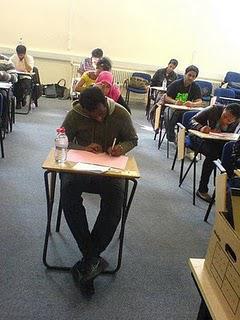 Halfway there! I tell myself as I cycle to Bureau Inburgering Utrecht for my final day of NT2-II testing.
Halfway there! I tell myself as I cycle to Bureau Inburgering Utrecht for my final day of NT2-II testing.
No, I don't mean halfway to the testing center. I mean halfway to the end of NT2 testing. That is, assuming I pass. I'm feeling good about my tests from the previous day and today is Reading and Speaking, which are my two average areas. But not so average that I think I'm going to bomb. Average as in, my abilities in both these areas are average and that's exactly what you need to pass the test.
I get to the testing room, take a seat and open my latest read... Percy Jackson en De Zee van Monsters (please don't say anything... I've only just gotten over the fact that my level of Dutch has reduced me to reading 'tween' books). Nothing like a little practice before the exam. I'm only two pages into the newest chapter when the moderator comes to get us.
It's the matronly lady from the day before. She still has her younger colleague, but it appears to be a different younger colleague. I wonder how it makes her feel to constantly be working with girls young enough to be her daughter.
We walk into the room and troll the aisles between rows of cubicle desks looking for our names. I find mine quite easily and sit down, pulling out my ID, exam letter and dictionary. I've traded my husband's gargantuin, beat-up English Dutch dictionary for the all-Dutch Van Dale version of the NT2 dictionary.
The older moderator comes around checking ID, getting our signatures, and checking our dictionaries for cheat-sheets. A laminated paper much like the one we were given the previous day before the listening tests is lying on each desk. The message is clear: it was time for...
Lezen
We are given a few minutes to pour over the instruction sheet. It's the same as the day before for the listening portion. Only the backside goes over the instructions for the reading exam. The moderator reads the most important point to us as we follow along.
Next comes the test booklets. We habitually scribble our testing numbers on the front cover and wait for the moderator to go over the instructions. We have 100 minutes to answer 43 questions pertaining to various articles. The articles are all contained in the booklet and we are free to make whatever notes in the booklet we need to. The questions would appear on the computer screen followed by multiple choice answers. Once we had clicked on the letter corresponding with the answer we wanted, we are ushered to a refreshed screen with new questions and answer choices.
Each article in the booklet has at least three questions that go with it. I like to handle these sorts of tests by reading the question first and then skimming the article for the answers. I'm done in enough time to go back and check a few that I was uncertain about.
Finishing a few minutes early means getting to the bathroom before the line forms. I'm taking the last sip of my coffee when the younger moderator's head pokes out from behind the door of the exam room to let us know that it's time for the next section.
Spreken
This exam is a breazy 30 mintes long. Quite a relief after 120 minutes of writing, 70 minutes of listening, and 100 minutes of reading. I'm a bit nervous about this one, but calm myself with deap breaths and by convincing myself that if I can conduct interviews in Dutch and explain my latest symptoms to the doctor in Dutch, this shouldn't be too difficult.
Out come our grotesquely massive helecopter pilot headphone friends from the day before. Only this time, we get to pull out the fancy little mouth microphones attached. There's no laminated card with instructions, but a box shows on the screen filled with volume measurer, control buttons and all kinds of other gadgets.
We get our test booklets, fill in our test numbers and wait for further instructions. For all that the speaking test controlers are on the screen before us, there is no mouse with which to click on the buttons. Just like with listening the day before, everything is controled by the moderators. All of us are hooked up to a tape that plays through the test and the moderators control the stop and start of the recorder.
Once the test begins, we speak our test numbers clearly into the microphone. The booklets contain the questions with pictures included. Before we know it, the tape has been started and off we go.
The first section are short answers. You are given about 10 seconds to compose an answer before the tone, and ten seconds to answer between that tone and the one signifying the end of your time for that question.
Sample Question: "Your backpack was stolen You call the police. They want to know what your backpack looks like so they can recover it. What do you tell them." There's a nifty photo to go along with the question to help you better answer the question.
In the second section, you have a bit more time: 20 seconds to think and 20 seconds to answer. Like the first section, you hear the questions via the earphones as you follow along in the test booklet. You have a pen to jot down anything you need to and have the time between peeps to give your answer.
Sample Question: "You work for an eyewear company. You are having a sale and have asked a printing company to print sale flyers. The flyers are delivered and you open the box to discover a mistake in the printing (in booklet was a photo of a flyer with the text upside-down). You must call the printing company, explain the misprint and tell them how you think the problem should be solved."
The third section is by far the most advanced. The good news is that you have two whole minutes to think about you answer. The bad news is that your answer has to be two minutes long. There are only two questions in the thrid section, but they are very involved. Expect graphs, diagrams, and several points that you will need to address in your answer.
Sample Question: "You are on the board of a chess club. At your annual meeting, you are to tell other members that the board has decided to raise membership fees. There are several members who will not be happy with this decision. You need to expain to them the reasons why you have decided to raise the fee, how much the fee will go up, and what the club plans to do with the extra money."
What I woudn't give to be a fly on the wall when they grade my speaking tests. It may have been a Dutch speaking test, but if they listen closely they'll hear just as many English expletives after each final peep tone as they did Dutch words during my answer.
I left the testing center feeling relieved that it was all over, but with stomach churning at the thought that I'd have to wait 4-6 weeks for my results.
Expat Magazine
Author's Latest Articles
-
Good Night Irene
-
Comment on If You Ain’t Dutch, You Ain’t Much! by Tiffany
-
Comment on Expat’s Best Friend by RANDOM NOMAD: Turner Jansen, American Canine in Holland « The Displaced Nation
-
Comment on Driving Rant: Electronic Advisory Speed Signs During Rush Hour by Tiffany

